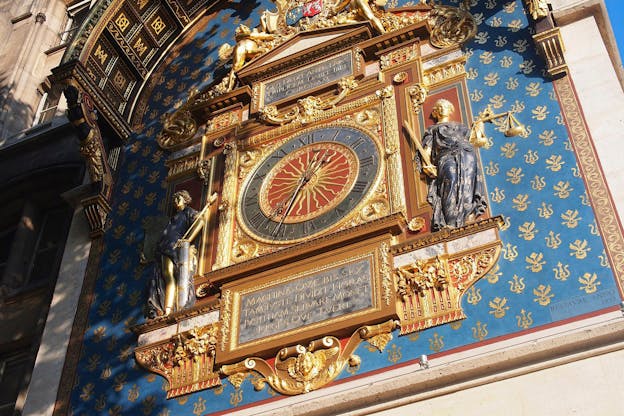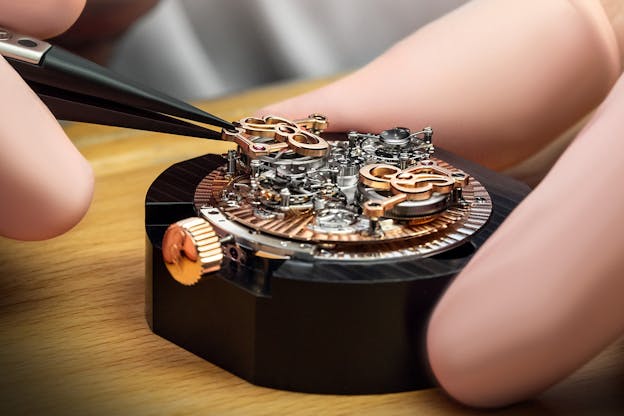In Depth: The Breguet Classique Double Tourbillon ‘Quai de l’Horloge’ 5345
The latest version of Breguet’s orbital double tourbillon showcases one of modern watchmaking’s most ingenious mechanisms.
Breguet’s Double Tourbillon Quai de l’Horloge is named for a street in Paris, on the Île de la Cité, which sits in the middle of the Seine, which is both the geographic and in many respects, the historic center of the city as well. There was a Gallic settlement on the island by the third century BC, then it was a Roman outpost, and in 508, Clovis I, the first King Of The Franks, built his palace there. Quite a bit later, in 1370, the first public clock in Paris was installed on the corner of the Quai de l’Horloge and the Boulevard de Palais; the clock is on the facade of the Palais Justice.

Even later than that – practically yesterday – Abraham Louis Breguet set up shop, in 1775, in the premises at 39 Quai de l’Horloge.
The first version of the Classique Double Tourbillon, the ref. 5347, was introduced in 2006. This first version has the same basic technical features as the following versions. Two tourbillons, as well as their going trains and mainspring barrels, sit on a rotating platform carried on ball bearings, and supported by a rigid, non-rotating baseplate. The mainspring barrels are linked by a central differential, around which the tourbillons, gear trains, and mainspring barrels rotate. The differential is driven by the mainspring barrels, whose rate of unwinding is controlled by the tourbillons, and the differential averages the the two speeds to produce a single rate which controls how fast the platform – as well as the dial mounted above it – turns. The dial is decorated with guilloché and the watch is both large in diameter and very thick, at 44mm x 17.95mm.

The platform rotates once every 12 hours, and the upper bridge for the two tourbillons functions as an hour hand. The minute hand is driven separately by motion works (just as in an ordinary watch, where the hour hand makes one revolution every 12 hours, and additional gearing driven off the cannon pinion, which carries the hour hand, drives the minute hand). Most of the mechanism, except for the tourbillons, is hidden under the dial, although there are a number of gears visible on the back of the movement, which are held in place by an elaborate set of bridges.
The 5347 has been produced in several different versions, including red enamel over guilloché (flinqué enamel) as well as a gem set version, ref. 5349, which was seen on Christiano Ronaldo’s wrist in 2019 – the 5349 is 50mm in diameter, the largest version so far of the Double Tourbillon. The 5347 was not a ‘Quai de l’Horloge’ model – those later models would both, as we’ll see, feature engravings of the building at 39 Quai de l’Horloge; the original 5347 had a back plate engraved with a design based on the planets of the Solar System.
The next model, the 5345, was released in 2020. The 5345 does away with the dial entirely. This means a couple of things. First, the dial had functioned as the upper bridge for the mainspring barrels and one of the going train wheels. The dimensions of the watch changed slightly, to 46mm x 16.80mm, with a domed box crystal enclosing the platform for the tourbillons, going trains, and mainsprings. With the dial gone, the role of an upper bridge for the barrels and two going train gears was taken on by a very elaborate pair of bridges shaped like a capital letter B, for Breguet. The shape of the letters is that created by Breguet during his lifetime, visible on the secret signatures engraved on the dials of his watches.

The engraving on the back of the watch had been updated as well. Instead of the planetary motif, Breguet this time around chose to close the open bridge assembly of the original 2006 ref. 5347, in order to create a more-or-less unbroken surface on which to engrave a portrait of the façade of 39 Quai de l’Horloge, although the actual number of bridges is the same.

The engraving is extremely detailed – there is even a tiny image of a woman, looking out one of the upper storey windows.
The New Ref. 5345 Quai de l’Horloge
The new model is technically identical to the 2020 version. The arrangement of the tourbillons, trains, motion works and mainspring barrels are the same. The aesthetics are different in some respects, and in one major respect; the engraving of 39 Quai de l’Horloge has been updated. The bridges and rotating movement plate are now in rose gold, and the rotating plate retains the wave motif guilloché found on the version from 2020.

The design for the Breguet Double Tourbillon’s movement, the Breguet caliber 588, was created by Jean-François Ruchonnet, who also produced the original design for the belt-drive TAG Heuer Monaco V4. Although the visual pyrotechnics are considerable, the patent does state that the system should at least theoretically provide some chronometric advantages as well.
The patent reads in part, “The present invention concerns a watch with a mechanical movement and it relates to the reduction of rate variations which result from the effects of gravity on the regulating members of the watch, because of inevitable faults in the poising of such members, and because of the variation of these effects in the various positions that the user imposes on his or her watch … instead of aiming to compensate for disequilibria in planes other than the general plane of the watch, the present invention reduces variations in rate by using a time base whose frequency is the mean of those of the two tourbillons mounted on a common support.”
In watches with more than one balance which are equipped with differentials, there is generally a single power source, with the differential somewhere downstream from the mainspring. In the Breguet Double Tourbillon, the differential is driven by, and averages the rate of, the mainspring barrels directly. This means that there is no intermediate mechanism between the mainspring barrels and the tourbillons which might reduce available torque to the balances (except, of course, for the tourbillons themselves). Any difference in rate between the speed of rotation of the mainspring barrels will tend to be reduced, as the two barrels share energy via the differential.

The engraving on the back now shows a view of the Quai de l’Horloge which Breguet would have been unable to experience himself (well, it would have been barely possible; the first hot air balloon with human passengers flew in 1783) and it shows the street, and no. 39, as seen from the air.

One change you notice almost immediately is in the shape of the three bridges – the rectilinear borders of the 2020 version are now rounded, flowing curves that harmonize visually with the curvilinear composition of the rest of the scene. The view is of the Île de la Cité as seen from the western end – the bridge is the Pont Neuf, which separates the rest of the island from its westernmost tip, on which is an equestrian statue of Henri IV. You can just make out the head of the horse right at the edge of the engraving, at about 4:00; the statue still stands today. The lower walkway to which you can descend via flights of stairs is shown abutting the Seine (“quay” means “dock” and boats dock along the embankment). You can see very detailed foot traffic on the bridge, as well as on the island proper. The Quai de l’Horloge is seen, following an arc away towards the east, and just inland on the island is the Place Dauphine – no. 39 had doorways on both the Place Dauphine and the Quai de l’Horloge.


The new engraving is light, almost airy, and has a wonderful natural feel despite the bird’s eye perspective; it gives the scene a dynamism and depth less present in the flat, face-on engraving of the 2020 model. Both are tour-de-force examples of the engraver’s skill. The plate is gold, and has been given grey, black, and white lows and highlights through the application of black and white rodium coatings, which are used to provide a sense of contrast and distance behind the rooftops at the top of the engraving, and to show reflections and currents in the Seine. Breguet says that creating the engraving takes about 100 hours of work.

Movement finishing is exemplary, as is overall attention to detail. One of many interesting features are the easy-to-miss Roman numerals engraved on the inner vertical surface of the case, which are filled with black enamel and give the impression of shadows cast by the blue varnish-filled Roman numerals on the sapphire ring above them.

The double tourbillon system on a rotating platform requires very careful distribution of energy from the two mainspring barrels. However, other aspects of the watch which are less center-stage required just as much inventiveness. Those gears under the three bridges on the back, for instance, are part of a system designed to prevent any unwanted play in the position of the rotating mainplate. Also hidden under the back plate of the movement, is a system of antishock springs supporting the ball bearing race on which the rotating mainplate turns.
Allowing time setting and winding in the Breguet Double Tourbillon presents a major challenge; the crown must be able to wind the mainspring barrels no matter where the are in the rotation cycle of the moving plate, and similarly, since the moving plate carries the hour hand, setting the time involves moving the entire rotating plate and everything on it. (If you’d like to see the various components more clearly, I highly recommend the exceptionally interesting and detailed Deconstruction of the 2006 model over at The Naked Watchmaker).


Even in photographs, the watch is almost overwhelming; it is one of the most imposing tourbillons in the world, double, triple, quadruple or otherwise. Its mechanical ingenuity is at least as impressive as the raw visual impact (which is saying something). It is really nothing more nor less than a monument to Breguet. The stylistic relationship is obvious, but as an invention, it’s also very much in keeping with Breguet’s almost inexhaustible capacity for inventions, complications, and sophisticated mechanical solutions.
Breguet even in the last two decades, has created and patented a number of different innovations; the Double Tourbillon is one of the better know but there are many others as well. The Double Tourbillon Quai de l’Horloge, 2024, is a memorial to and celebration of one of watchmaking’s greatest innovators, in both design and mechanics – and is also, in its own right, a no-holds-barred expression of both classic craftsmanship, and invention, in modern watchmaking.
The Breguet Classique Double Tourbillon Quai de L’Horloge: case, 18k rose gold, sapphire box crystal, with sapphire crystal caseback; 46mm x 16.80mm. Not waterproof. Sapphire dial with Roman numerals and minutes track, engraved and filled with blue varnish. Movement, double tourbillon caliber 588N2, 37mm x 12.6mm, running at 2.5Hz in 81 jewels, with orbital platform carrying the tourbillons, going trains, and mainspring barrels; central differential for averaging the rates of the two tourbillons. Steel hour hand forming the bridge for the two tourbillons; bridges for mainspring barrels and train wheels, gold Breguet letter B. On the back of the movement, gold plate and bridges, treated with white and black galvanic rhodium coating, with view of the Quai de l’Horloge as seen from above. Hand wound, 60 hour power reserve. Strap, blue rubber, with triple folding rose gold clasp. Price, $735,100. Find out more at Breguet.com.

